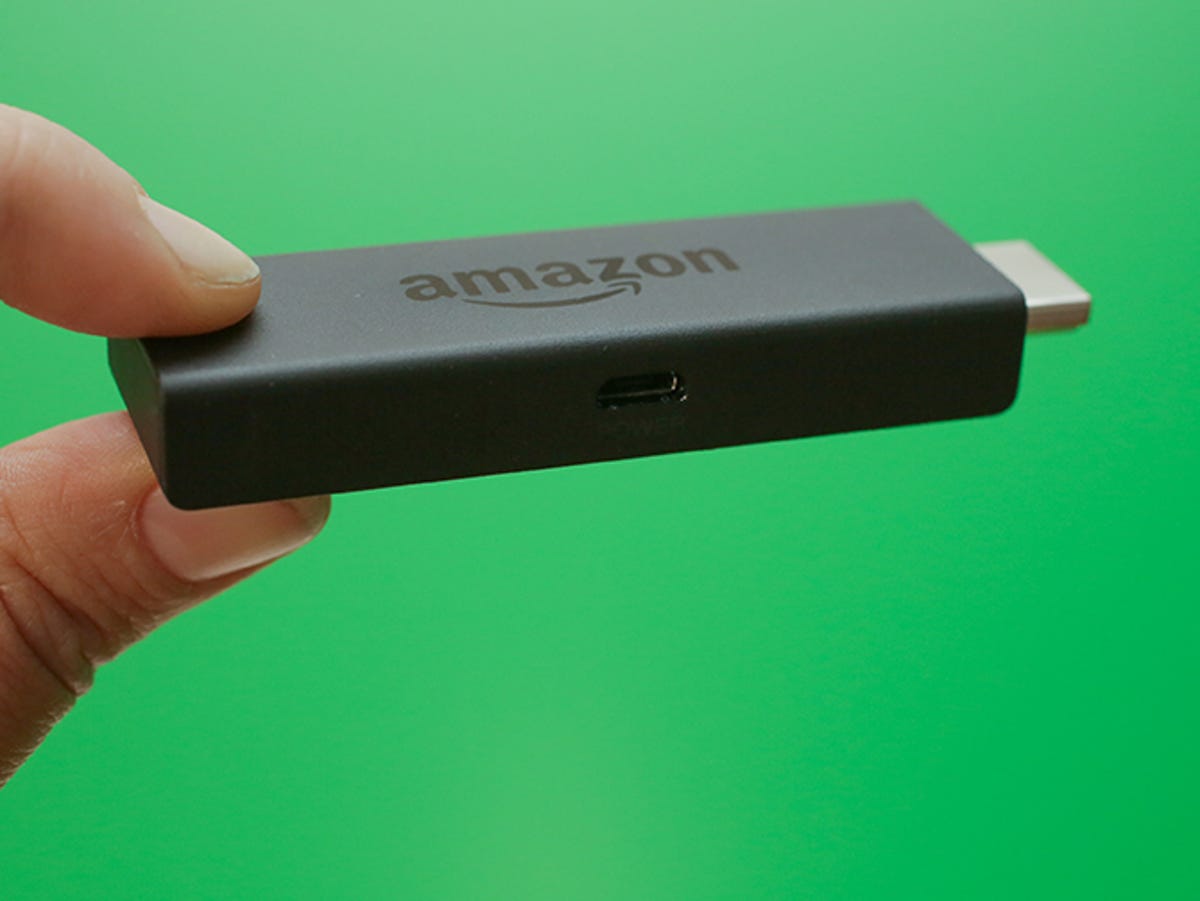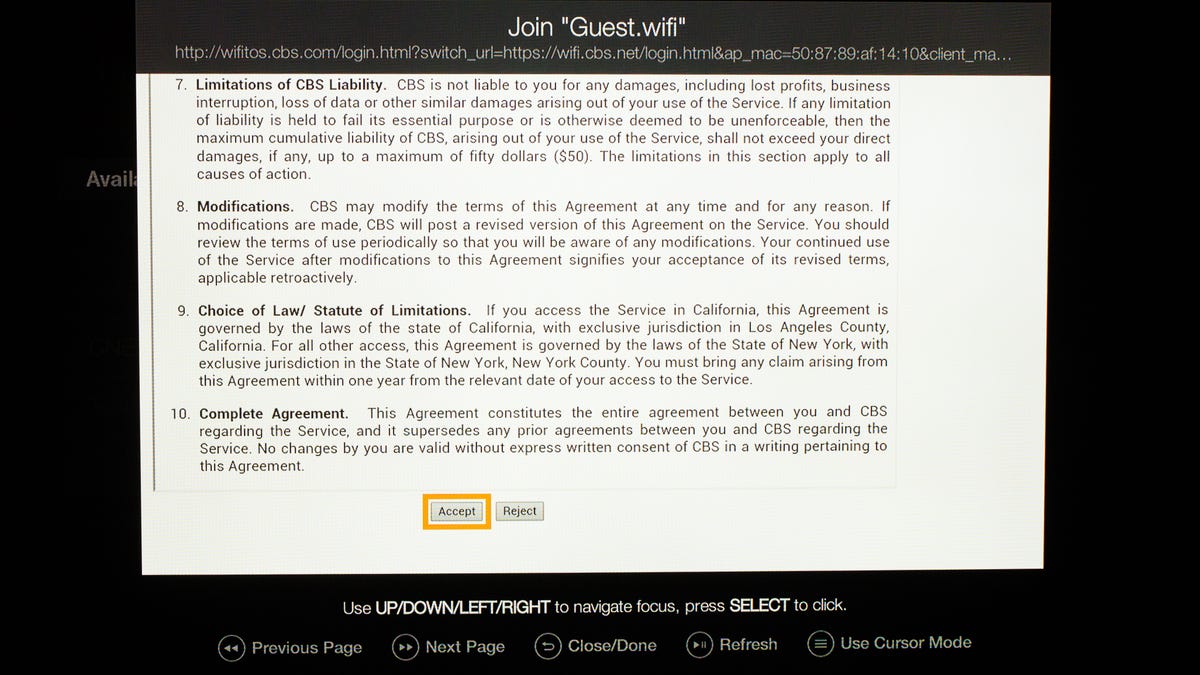
Sarah Tew/CNET
At home you have access to umpteen streaming video choices, but in a hotel you’re a captive audience, and subject to the often archaic or wildly overpriced offerings of the hotel’s system. Your favorite streaming device might be small enough to bring anywhere on the road, but that doesn’t mean it will actually work.
A new feature called captive portal access can break you out of entertainment lockdown. The feature is now live on Amazon’s Fire TV Stick and Fire TV box, making them hotel-friendlier than any other streaming device.
Now you can use your Fire TV with your hotel’s Wi-Fi or wired Internet connection, even if those force connecting devices to see a special Web page to grant access. Such pages are typically filled with fine print, advertising and confirmation buttons, and might even ask for your name or room number. The Fire TV’s native network setup screen now allows you to click “I agree” and input that information, after which you’ll have all the connectivity your hotel room offers.
In addition to hotels, captive portal authentication is common in college dormitories, apartment complexes and offices. The feature should work on them all.
Hands-on testing: Yep, it works
One such office is CNET’s New York headquarters, where the guest Wi-Fi network not only requires a standard password, but afterward forces you to accept the terms of service via captive portal before you can connect.


Sarah Tew/CNET
I did just that, selecting the network and inputting the password as usual via my Fire TV Stick’s onscreen keyboard. After a few moments, without me having to do anything else, the captive portal authentication screen appeared. I scrolled down to the bottom using the remote’s cursor key, and selected “Accept.” The screen disappeared, the system indicated that I was connected and streaming worked normally.
I tried both the Fire box and stick and both worked well. It’s worth noting that some captive portal systems work via wired connections too, so the bulkier, more expensive box’s Ethernet port makes it the more versatile of the two. The Fire TV Stick operates only via Wi-Fi.
Meanwhile no other home entertainment device I know of can navigate captive portals, including small, portable streaming devices like the Roku, Chromecast and Apple TV .
I asked Roku’s spokeswoman why Roku lacked the feature and whether it could be added in the future. Her response was that captive portal access is “definitely an interesting topic. We haven’t made any announcements related to captive portal support at this time, but we’ll be sure to keep you updated on anything specific to this feature.”
Laptops, tablets and phones usually have no trouble with captive portal access because their Web browsers can see and input information into the authentication screen.
Passwords and room numbers covered too
Some hotels and dorms require you to enter a name, password, room number or other information, an issue that tripped up CNET’s John Falcone when he tried to connect a Chromecast during a hotel stay. I didn’t test such a connection, but according to Amazon the Fire TV’s method should work fine with these kinds of systems too.
I spoke to Matthew Wheeler, president of The Network Operations Company, which handles guest Internet access for clients such as Hilton, Best Western and Wyndham hotels. He confirmed that the Fire TV should have no problem with room numbers and other authentication requirements.
“Amazon’s method provides the most practical answer for anyone who wants to take a streaming device on the road,” Wheeler said.
One advantage is Amazon’s “cursor mode” and page forward/back options, which allow navigation of more complex sign-in systems that can stymie other devices. Wheeler said that since Amazon’s system works like Apple’s iOS and OS X, which also launch the authentication screen as soon as you try to connect to the network (as opposed to within a separate browser) it’s the easiest for guests to use.
He added that his company’s system could be modified to work with a Roku, for example, but it had to be custom-programmed to recognize Roku’s DHCP host name to bypass the authentication screens. He mentioned a few devices with other workarounds, for example a PlayStation game console’s Web browser. Some hotel guests log in to captive portal systems using travel routers, but that requires an extra device and a bit more technical expertise than Fire TV’s system.
Another advantage according to Wheeler is that screen mirroring — where you cause the contents of another device’s screen to appear on the TV — also works with Fire TV on a guest network, as opposed to something like a Chromecast that relies on a device-to-device connection that’s often blocked.
On the other hand, a Fire TV’s screen-mirroring device support isn’t as robust as a Chromecast or AirPlay. To get the best experience, according to Amazon you’ll need a Fire Phone , a Fire HDX tablet or a device running Android 4.2 (Jelly Bean) or higher.
According to an Amazon spokeswoman other Miracast devices (including Windows 8 PCs, Windows phones and tablets) are not supported, meaning that they “will work but…it’s not going to be the best experience possible from a customer standpoint.” Another unofficial option is third-party apps like AllCast.
The captive portal feature is currently available to every Fire TV device, stick or box, worldwide. For more information on how to get it, check out Amazon’s software update page.
Updated with comments from Roku and further details from Amazon.




